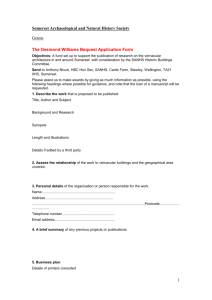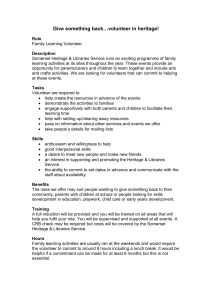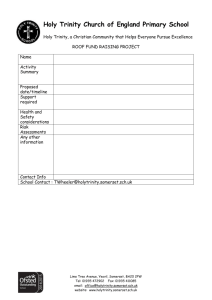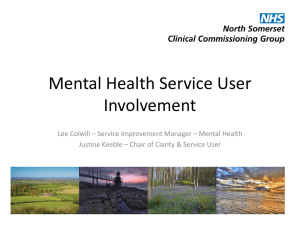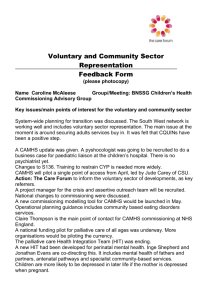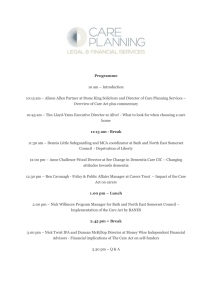Integrated Care in Somerset
advertisement
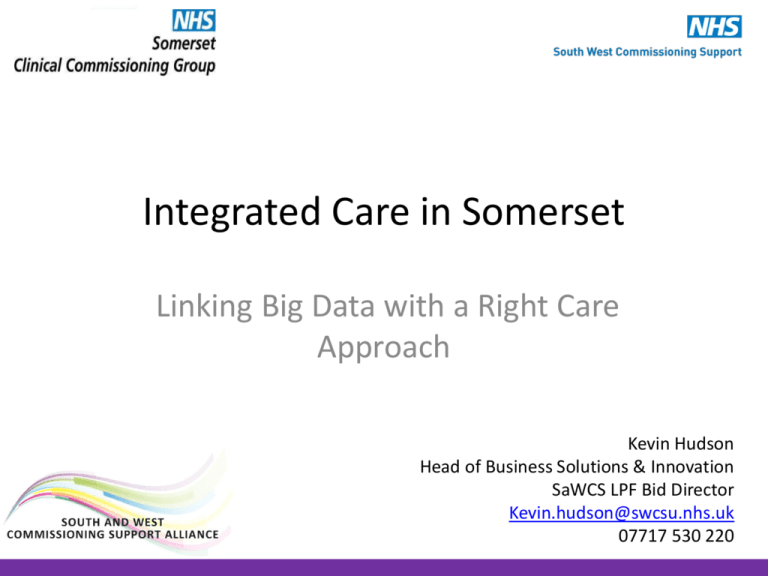
Integrated Care in Somerset Linking Big Data with a Right Care Approach Kevin Hudson Head of Business Solutions & Innovation SaWCS LPF Bid Director Kevin.hudson@swcsu.nhs.uk 07717 530 220 Context in Somerset Somerset’s imperatives for integrated care o Understanding those patients who would benefit o A person-centred approach o A radical ambition for commissioning change Our understanding of national Right Care principles (particularly in relation to data) o Where to look? (understanding what matters?) o What to change? (undertaking a deep-dive) o How to change? (equipping the commissioning tool-kit) Through this work we have discovered that local priorities and national initiatives can be one and the same 2 Telling the story through data – BIG DATA Most data analysis (and commissioning) is ‘episodic’ - Episodes of care, amalgamated over time and categorised by provider We built a Holistic data model – where the patient is the ‘base unit’, not the episode 577,000 Somerset patients – activity mapped and costed - All their encounters with all aspects of Health & Social Care - £676M of health and social care spending Cross-cut against all their diagnostic conditions (mapped from 400 Episode Treatment Groups recorded through Primary and Secondary Care Coding) Purpose of the model is to: – – – Help set the scope of Outcomes Based Commissioning Help set the focus within any agreed scope Help develop an evaluation methodology to measure change Biggest Challenge: Not how to build it but how to understand it Where to look? Cost by age….? Where to look? …or by condition? Morbidity (number of ETGs) by age band 100% 90% 80% Number of conditions 70% 0 Patients (%) 60% 1 2 50% 3 4 40% 5 6 30% 7+ 20% 10% 0% 0-4 5-9 10-14 15-19 20-24 25-29 30-34 35-39 40-44 45-49 Age band (Years) 50-54 55-59 60-64 65-69 70-74 75-79 80-84 85+ What drives cost – age or conditions? Regression variables Age Number of conditions Age, Number of conditions Variation explained 3.36% 18.76% 19.30% What matters? The Symphony Project wanted to get ideas and thoughts from people with lived experience and from current frontline staff. April Strategy were engaged to help do this and they undertook a series of activities in Autumn 2013. They: • Reviewed national and local publications (often based on patient and staff engagement) • Held one-to-one interviews with people with long term conditions • Facilitated a large event with people, carers and frontline staff. (it’s not all about data) People and carers’ shared hopes: Staff’s shared hopes: Insights were gathered about what works well now, what people hope to see more of and what they want to see less of in the future. 7 Deep-Dive What might you change? • Patients on Pathways? • Patient with Condition? • If so, which conditions? Starting point: Different conditions / characteristics Starting point: Multi-morbidity and Cost But not all follow this pattern… For multi-morbidity, number ≈ type For multi-morbidity, number ≈ type For multi-morbidity, number ≈ type For multi-morbidity, number ≈ type What to change? Multi-morbidity, not disease type How to change? (Equipping the Commissioning Tool-kit) • • • • Year of Care Budgets Patient Mapping / Social Factors Person-Centred Outcomes Personalised Care Planning And for the LIG’s (Local Implementation Groups) we map where the patient’s are… Number of Patients …their cost… Cost of Patients …and the setting of care (‘at home’ or ‘in a home’) Cost of Patients Mosaic Social Indicators can help inform scope and engagement: Type M56 – Older people living on social housing estates with limited budgets Key Features: • State pensioners • Low use of credit • Enjoy reading • Small housing • Basic education • Shop locally • Traditional • Lifelong council tenants • Face to face contact Communication Preferences: Access Information • Local Papers and Face to Face • Not Internet, Telephone, Magazines, SMS Text Service Channels • Face to Face • Not Internet, Mobile Phone or Telephone 2% Population, 8% of full cohort, 12% of high cost patients What matters – designing a outcome set The insights were used to create a mandate to guide the design work and formulate the outcome set Focus Outcome Features Enablers Me and my carer (s), taking account of all my conditions and our physical, mental, social and emotional needs I am helped to manage my conditions and live in the way I want to the best of my ability ACTIVE INVOLVEMENT POSITIVE RELATIONSHIPS EASY ACCESS I am listened to and involved in planning and making choices about my care in a way that suits me. I have one key person who takes ownership for coordinating all aspects of my care. They make me aware of all the options and keep me informed about what’s happening. They understand me and I trust them. I can contact my care coordinator when I need to. I am given access to information, education, advice and expertise to help manage my condition. Support and services are available as close to my home as possible and I know there is a 24/ 7 response available if I need it. SEAMLESS COORDINATION I receive seamless timely, coordinated care with easy, efficient transitions from one service to another. Professionals across all services have access to an up-to-date shared record of my condition, needs history and services and treatments I am receiving. • Caring, compassionate, competent and knowledgeable staff work in multi-disciplinary teams across organisational boundaries with up-to-date, shared records, facilitated and supported by organisations and systems. • Patients and carers are asked for feedback on services and see improvements happen as a result. 23 Outcomes Hierarchy Personalised Care Planning Training “It has been really interesting to see how the medical model is driven by tests, tasks and numbers, rather than by the individual. I am really positive about the opportunities Care Planning presents for partnership working and to get the voluntary sector and other services involved in healthcare.” Personalised Care Planning and Support Training Courses 2014/15: Venue / Location Frome Medical Practice (delivered by National Training Team) Irnham Lodge Surgery, Minehead Woolavington Surgery North Sedgemoor Federation The Thatch Cottage, Shepton Mallet The Meadows Surgery, Ilminster North Sedgemoor Federation Wells Health Centre Williton Hospital, West Somerset Springmead Surgery, Chard Yeovil District Hospital Taunton Deane Federation Frome Medical Practice Taunton Deane Federation Available to book Available to book Yeovil District Hospital Bridgwater Hospital Available to book Taunton Deane Federation Date of 1 day ‘Making it Happen’ 10/0714 21/10/14 09/01/15 21/01/15 26/01/15 03/02/15 11/02/15 25/02/15 12/03/15 16/03/15 24/03/15 30/03/15 01/04/15 16/04/15 07/05/15 19/05/15 03/06/15 16/06/15 29/06/15 07/07/15 22/07/15 No. of attendees Regional Lead, Age UK 11/09/14 25 11/11/14 20/02/15 10 7 09/03/15 17/03/15 25/03/15 08/04/15 23/04/15 27/04/15 05/05/15 11/05/15 13/05/15 28/05/15 18/06/15 30/06/15 15/07/15 28/07/15 03/08/15 18/08/15 02/09/15 10 9 7 “The Care and Support Planning training gave me a ‘light bulb’ moment about preparing patients for their annual reviews. It acted as a useful reminder in these busy times, that putting a bit of time into empowering the patient can have positive rewards in terms of subsequent use of services as well as clinical outcomes” Date of 1/2 day follow-up GP “Self-reflection of my consultation skills. I have realised that patients may not always hear what I think I am saying. I will also try to dig deeper to find their real story and agenda, rather than just doing what I think it is.” Practice Nurse 25 National Coverage • Symphony data analysis was covered on the front page of HSJ – April 2014 • Professor Andrew Street also recorded a video: http://www.youtube.com/ watch?v=Cr7aevRGBqM (or search Youtube for ‘integrated care in Somerset’) • Published in International Journal of Integrated Care – January 2015 (after academic peer review)

